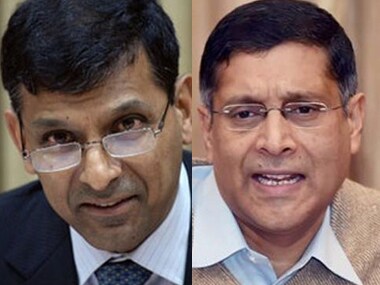The government’s two five-star economists Raghuram Rajan, of the Reserve Bank, and Chief Economic Advisor Arvind Subramanian, seem to be poles apart when it comes to their readings on inflation. Rajan is still in two minds on whether to cut or not to cut rates; he is unsure where the recent fall in retail inflation to 3.8 percent is an aberration or a trend indicator. His mandate is to bring retail inflation down to 4 percent. Subramanian, on the other hand, frets that “in terms of the prices measured by the national income accounts, we are closer to deflation territory and far, far away from inflation territory.” Who is right? [caption id=“attachment_2419510” align=“alignleft” width=“380”]  Raghuram Rajan and Arvind Subramanian[/caption] Before we answer this, we need to put a caveat or two in place. Often what seems like opposite interpretations of the same set of numbers may merely be the result of where you sit. If you are sitting in an igloo on the north pole, the equator is to the south and there is no point arguing that the equator is to the north - which is what the one sitting among penguins on Antarctica will claim. So, to expect that North Block, whose ambit is the whole economy, and Mint Street, whose focus is inflation, to have the same ideas about inflation and deflation is a bit much. Where you are makes a difference to how you see. Secondly, monetary and fiscal policies are not mutually exclusive. While Rajan and Subramanian’s boss Arun Jaitley may not be the best of pals today due to their differing ideas about where interest rates should be headed, the truth is both of them can impact the policy lever controlled by the other. For example, Rajan can, by keeping rates high or tinkering with the prudential norms for recognising bad loans, light a fire under nationalised banks, which forces the finance ministry to recapitalise banks faster - actions that directly impact the fiscal deficit. On the other hand, when the FM offers interest subvention schemes for the poor or keeps post office rates higher than bank deposit rates, he is directly impacting interest rates and monetary policy. Does it make sense for an FM to talk about lowering interest rates when he has actually ensured this for housing loans to weaker sections, and eliminated SLR for infrastructure loans? Moreover, if Jaitley is so bugged by higher rates, why does he not cut rates on postal deposits and public provident fund and national savings certificates, which distort the market for money and credit? The bottomline is simple: Rajan and the FM have different jobs to do, and both can invade the other’s territory by their own actions. Neither of them is powerless to impact the other area. For the FM to blame the RBI is just buck passing. Monetary and fiscal policies are interdependent to a certain degree and each also impacts the other directly. Now, let’s try and settle the question of who is right, Rajan or Subramanian? Or rather, who is likely to be more right? The short answer is Subramanian is more right than Rajan, but this does not mean the latter has to kowtow to the finance ministry’s line on rates. The Reserve Bank, for right reasons or wrong, has chosen to look only at retail inflation to decide monetary policy, and has said as much; it cannot now change the goalposts and decide it will take cues from wholesale price trends. By doing so, it will confuse the markets. Moreover, the finance ministry’s brief to the RBI is to target retail inflation levels, not wholesale. So no one can say the RBI is doing the wrong thing. Subramanian’s arguments are simple; the deflator used to calculate real gross value added (GVA) growth is at near zero levels (at 0.1 percent). This means inflation is at super low levels, and almost gone. (GVA is the new method adopted this January to estimate national income as against the earlier method of calculating growth from output, which is GDP). The problem is that the consumer price index (CPI) is still showing 3.8 percent inflation, while the wholesale price index (WPI) is at minus 4 percent. CPI is suggesting disinflation (where price rise is merely slowing), while WPI is indicating deflation (where prices are actually falling). One way to resolve the question is to average CPI and WPI, and we would get 0.1 percent - the exact level the GVA deflator shows. External indicators - falling exports, falling real estate prices, high discounting on durables and non-durables at retail malls and e-commerce sites - also indicate that consumer and investment demand is still weak, especially rural demand. The chances are we are closer to deflation than we think, especially since the world environment is still trending weak. China, Europe and Japan are printing money to keep deflation away, and the US may still chicken out of a rate hike this month. Oil prices are falling as if fossil fuels are going out of fashion. There is thus a case for cutting interest rates now, but even if Rajan holds back, the finance ministry can reflate the economy on its own. OROP (one-rank, one-pension) will spice up consumer demand, just as the pickup in public investment does. Jaitley can ease up on fiscal conservatism as long as the quality of the fiscal deficit emphasises investment rather than just consumption. At the end of the day, Jaitley has more levers to act on than Rajan. He should start using them.
There is a case for cutting interest rates now, but even if Rajan holds back, the finance ministry can reflate the economy on its own
Advertisement
End of Article
Written by R Jagannathan
R Jagannathan is the Editor-in-Chief of Firstpost. see more


)

)
)
)
)
)
)
)
)



